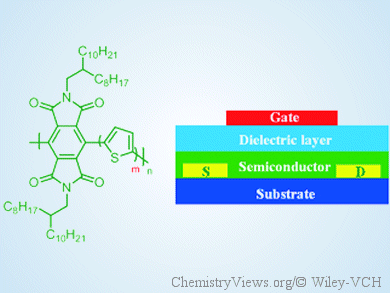Organic field-effect transistors (OFETs) are important components in organic electronics. Semiconducting polymers are promising active layers in OFETs because their optoelectronic properties can be tuned, and they are solution-processable as well as mechanically flexible. A powerful strategy to achieve high carrier mobility in semiconducting polymers is the synthesis of an alternating conjugated polymer from electron-rich (donor) and electron-deficient (acceptor) units.
With this in mind, a series of pyromellitic-diimide-based donor–acceptor conjugated polymers with different donor/acceptor ratios were developed by Jian Pei, Peking University, China, and co-workers. The photophysical and electrochemical properties of these polymers change regularly as the donor/acceptor ratios of them vary. Moreover, as the donor/acceptor ratios of the polymers increase, the electron mobilities stay almost the same but the hole mobilities increase dramatically. Thus, the charge-transport properties of these polymers can be tuned accordingly.
The group hopes to use this rule to develop other new types of conjugated polymers for high performance OFETs.
- Tuning the Charge-Transport Property of Pyromellitic Diimide-Based Conjugated Polymers towards Efficient Field-Effect Transistors,
Xu Zhou, Yue Cao, Xiao-Ye Wang, Zi-Hao Guo, Jie-Yu Wang, Jian Pei,
Asian J. Org. Chem. 2014.
DOI: 10.1002/ajoc.201300228




